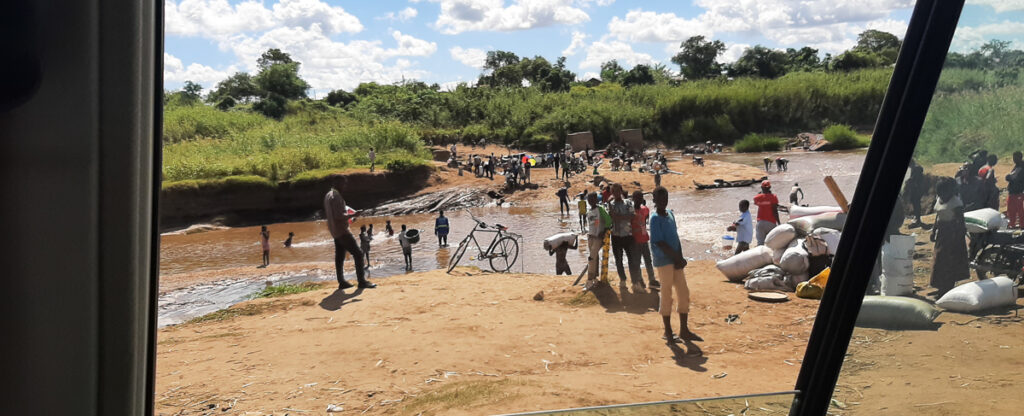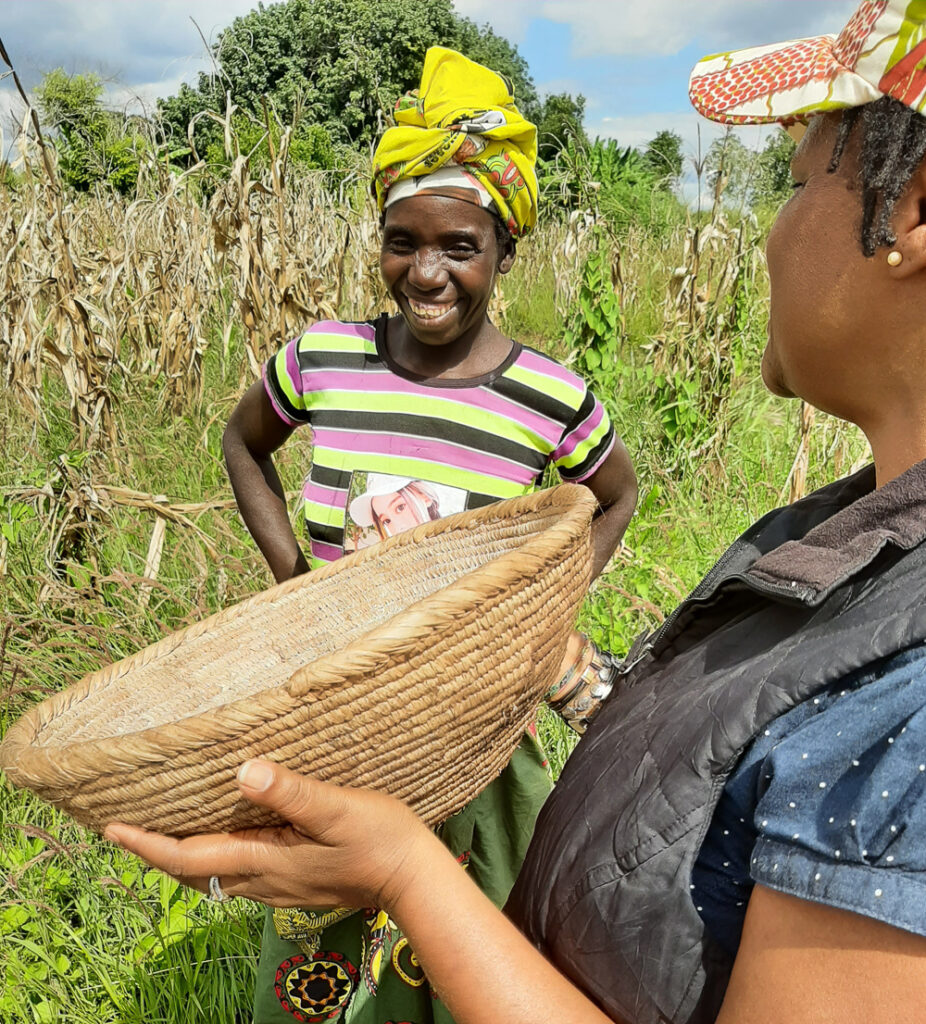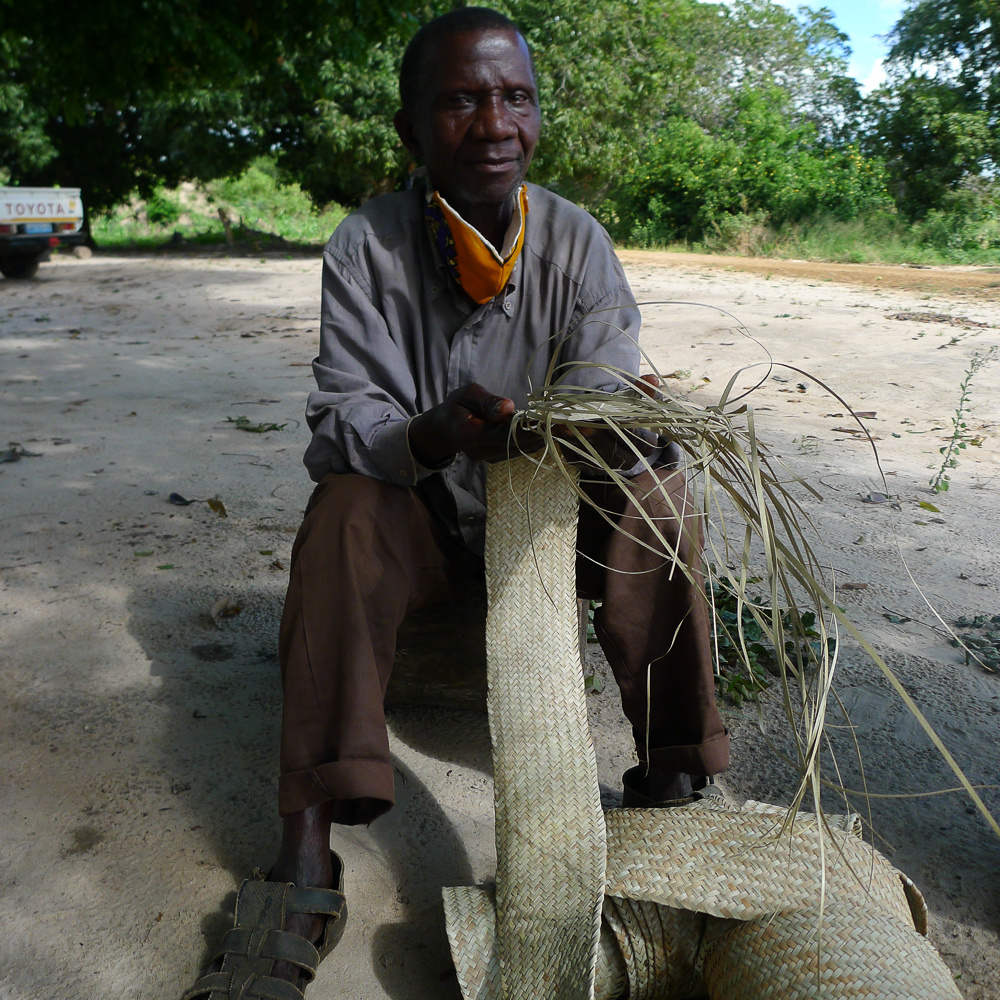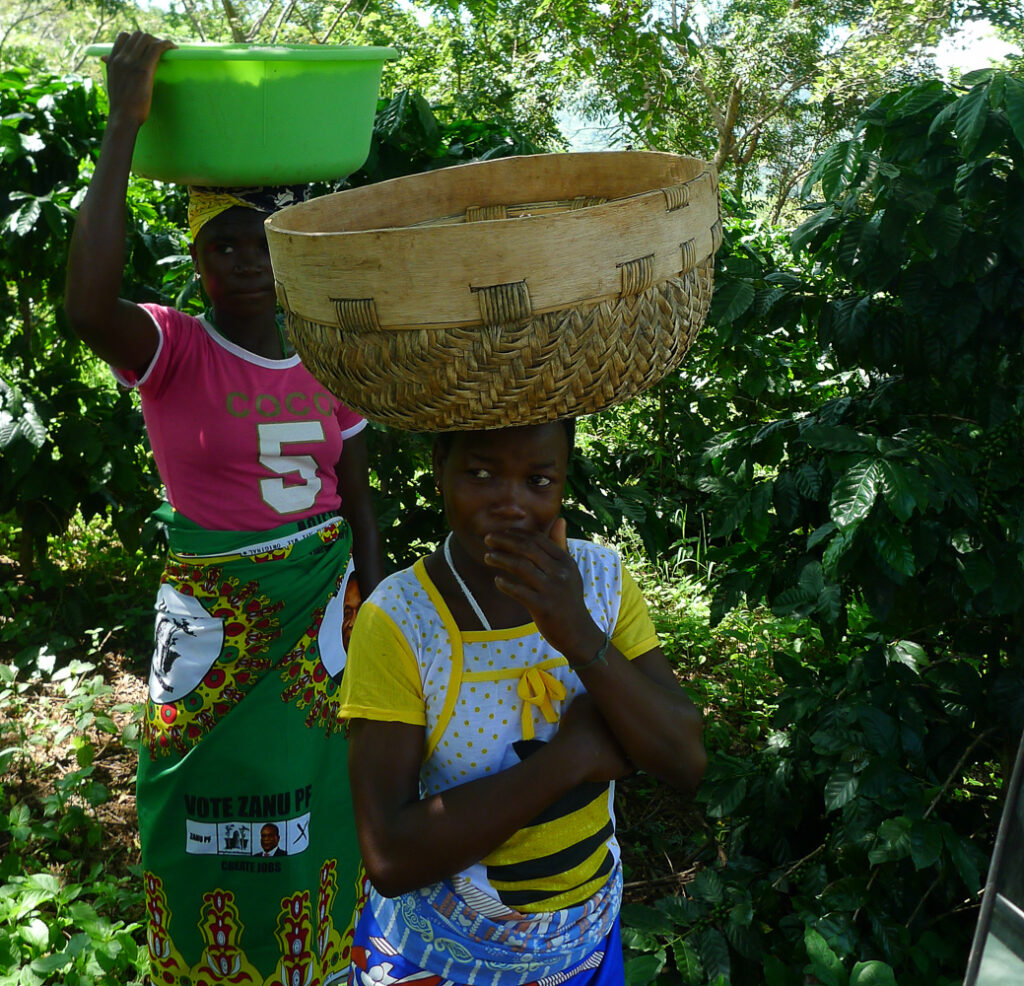Frances Potter reflects on the role of craft in Gorongosa, Mozambique, where life is precarious but memories are long.
(A message to the reader.)
“The centre of Mozambique doesn’t have much craft when compared with other areas of the country,” Florinda Neto declares. Florinda is a craft development specialist with the Sustainable Development Department of the Gorongosa Project, a Mozambican NGO which manages the Gorongosa National Park.
She points out that there is evidence that people in the area are capable of producing fine items, including beautiful baskets and skilful ceramics. These can be found in homesteads throughout the remotely scattered villages making up the buffer community that surrounds the Gorongosa National Park, in central Mozambique’s Sofala province. Here, crafts are sturdy utilitarian items, generally not made for trade or sale outside of the community, but bartered and traded between different households.
Located in the tropics, the Park and its surrounding areas are warm with distinct rainy and dry seasons, we were there in the dry cooler season. Rains are expected from November through March, the active farming season when roads become impassable and sometimes bridges are washed away. The area was amongst the worst affected in 2019 by Cyclone Idai.
Edson Carneiro, the senior manager of the Sustainable Development Department for the Gorongosa Project, elaborates that crafts are not considered a significant generator of livelihoods. He conjectures that the displacement of local people, initially during the Mozambican liberation struggle and later, through the years of civil unrest, together with a lack of exposure to craft development projects, might be some of the reasons for this.
There is an abundance of clay on the land around Gorongosa, together with evidence of various species of palm, as well as groves of bamboo and an abundance of banana plants. Recovered and found wood appears to be plentiful.
The Gorongosa Project envisions boosting income-generating opportunities for the buffer communities. A coffee-growing project was established on the mystical and imposing Serra da Gorongosa in 2013, which continues to flourish and expand. A more recent development is the steady promotion of environmentally beneficial honey harvesting as well as cashew cultivation—savvy businesses when they are combined with agricultural inputs, as well as health and education programmes. The initiatives are soundly interconnected, to enhance support of long-term conservation of this unique Park and its growing abundance of wildlife, and to sustain its communities. In COVID 19-free times, tourism is an invaluable contributor to local incomes. Any additional income is vital, given that the population of surrounding communities is estimated to be about 400 000 people, most of whom are located in small settlements far from urban centres.
Directing attention to improved living conditions for the girls and women of the Gorongosa community, craft, and hand-made production, is being tested as an additional and important source of cash income generation. The Gorongosa Project’s dedicated focus on women and girls will enable robust collaboration with communities to look for promising opportunities.
The lives of women across rural Gorongosa—in a similar vein to the lives of many women throughout Southern Africa—are governed by a highly patriarchal society. Matthew Jordan, head of the Sustainable Development Department explains: “For reasons of patriarchy and poverty, many girls find themselves married off by their families soon after their first menstrual cycle. The harsh reality for the majority of girls is that their education ends abruptly after primary school is completed”. He adds that increasing women’s livelihood opportunities through skills training combined with market access, will—as well as generating cash income to pay for food, clothing and education—enhance the dignity of girls and women, improve their status, keep girls in school longer and ultimately enhance the well-being of the entire community. Gorongosa Project, encouraged by the global demand for fine, well-designed handmade products, especially baskets, and products linked to the alluring story of Gorongosa, will invest in skills training, equipment and infrastructure to take advantage of this market trend so as to increase women’s livelihood opportunities.
To take it forward, developing the hand-made sector will investigate building and expanding existing skills, as well as the introduction of new techniques, materials and methods. The Gorongosa Project, and through its marketing arm, Our Gorongosa, a US-based private company with 100% of profits returned to the park, is committed to ensuring this.
Talking about the consistent evidence of fine basketry skills, Florinda believes that craft skills are kept alive mostly by older people. It takes a long time to make a fine basket. “And now they prefer to make things or grow things that earn money quickly”, she observes. The same holds true for the substantial clay pots found in the villages, used mainly for fermenting traditional beverages. Large woven food storage baskets are also useful throughout the communities. Florinda, who hails from Inhambane, has years of experience in design and handmade production. She has worked in the Gorongosa area for more than ten years. Previously, her energies were centred on close collaboration with households to improve the quality of commonplace utensils in daily use. Now her attention has turned to whether the same skills might be upgraded and used to generate income.
In consultations in May 2021 with women from the tiny villages of Canda, Casa Banana, Nhamacasa and Santa Fe as part of assets assessment, they stated that most of their time is taken up with working the small fields or farms, known as machambas. Food production is the women’s primary concern, whether it be for food security or to generate cash sales (as in the case of sesame seed production). Working the machambas involves arduous, back-breaking drudgery, undertaken primarily by the women.
What appears to be ubiquitous are large, sturdy, handsome bamboo baskets, peneira, and winnowing baskets, tsero. Basket owners treat these items with considerable care and respect. The baskets can carry heavy loads of grain, and their shape makes them much easier to carry on the head than plastic buckets. The tsero provide covers for nearly everything, including plastic basins.
Engaging in conversation with a group of women waiting patiently to take their turn at a diesel-driven grinding mill on Serra da Gorongosa, we ask them whether the baskets visible in the mill queue are made by the women themselves. They retort that women don’t have enough time to produce baskets, because they are busy with children and working their machambas. Certainly, there are plenty of babies around, reflecting the national population median age of 17.6 years.
At a meeting in May 2021 with a group of women weavers in Casa Banana, they said that before plastic was so cheap and easily available, they used baskets and that these are still in use in their homes. Speaking for the group, Fagresi Alfanet said: “We still make baskets sometimes because we like to remember things from before and because we use them in our homes. Making baskets takes time!”. The baskets and mats they make use palm (or mitcheu) not bamboo, which seems to be a material exclusively used by men. Men use mitcheu too, most often for complex plaiting, and twilling and twining.
Asked whether they would consider making baskets for sale to generate income, Fagrese speaks, again for the group: “We work to make sure we have food for our families, it is why we work in the machambas. The machambas are food. If baskets make money for food, we will make baskets.”
Working the fields is tough physical work which is regarded as women’s, rather than men’s, work. Apart from perennial fieldwork, women need to keep a constant guard against theft by monkeys and wild pigs. Once the harvest is gathered, and if it is plentiful, some is sold and the cash that is generated pays for school supplies, clothing, soap and essential commodities like oil and sugar. In the rural areas, there appear to be few sources of employment and the women talk of educating their children so they can find jobs in urban areas.
Fine examples of coiled baskets can be seen in community members’ homes. These are not what we expect, like the xirundu that are made in Inhambane, but turn out to be smaller and finer items produced locally.
- L-R Teresa Pecanino, Donate Chenazi,Elizabet Albeno, Pascoa Joåo, Sebastiana Costa Vasco, Santa Fé
- Geta António de Pascoa’s fine basket, Santa Fé – detail of double-sided fine weave – Santa Fé
- Costa Mustate, palm weaving, Santa Fé
- Sebastiana Costa Vasco, ceramicist, community health worker and leader, Santa Fé
- Teresa Pecanino’s ceramic pot Santa Fé
Highly skilled and versatile male weavers who are also in evidence weave various items for trade and sale. There is very little documentation of these baskets, but it is clear that they are made for sale and traded in the market places. It is in these marketplaces that the bamboo tsero can be found.
Over the years Florinda’s efforts have encouraged ceramic workers to explore expanding their product range beyond basic household cooking and storage pots. In many villages, aluminium pots are replacing the clay pots that were used on open fires, and plastic containers are used, all of which means that clay working expertise is at risk of being forgotten. Using only the tools which the clay ceramicists have on hand—such as mango pips and flat pieces from broken plastic water carriers—Florinda inspires local creativity and encourages the making ceramic pots for sale.
Rosita Domingos Amicho, a skilled ceramicist in Canda, a village which lies to the north of Serra da Gorongosa, details how she makes a living from selling beautifully executed pots to local people, and has also made customers of tourists and the urban residents of Vila da Gorongosa. Rosita produces an extensive range of planters. Her homestead is adjacent to a bottle-shaped kiln built some years earlier. The kiln, which is unique to the area, helps the Canda producers to get a more even heat and to fire more products at a time. It has enabled local ceramicists to expand their product range and boosted their sales. More traditional firing takes place in wood-fired pits or over open flame. Nevertheless, the method appears capable of producing sizeable and sturdy pots.
Other craft to be found in the area include wooden spoons carved from locally sourced soft woods embellished with detailed poker work. Tito Rafael, who trained as a guitar-maker, carves spoons and other small items for sale to supplement his income. He lives and farms on Serra da Gorongosa, where for him amongst his greatest expenses are educating his children beyond primary level when they have to move to live in a town like Vila da Gorongosa, 28 kilometres distant, where living costs are beyond the reach of most rural people.
There is an abundance of banana plants in this part of Mozambique. Florinda supervises the harvesting of banana leaf and testing to establish its commercial possibilities. She notes that while it is not a traditionally harvested fibre, it may produce interesting results in the future.
Craft sales are not listed as income in the Gorongosa Project’s 2020 Household Survey Report. Development and upgrading of expertise beyond purely manual skills, expansion of the existing fine craft skills and collaboration with women producers in the communities to access local, regional and international markets would enable this to become a meaningful income generator. A similar outcome has been achieved in neighbouring Zimbabwe, where the resilience of women-led organisations continues to deliver real benefits to women from their craft sales. Hopefully, project planning would allow enough time for the process to fully unfold; it needs wholehearted support and buy-in from women for them to assume ownership of the process.
This will secure the future for a unique set of skills located in a unique environment that is shared by communities and a distinctive natural ecology. It will join the Gorongosa Project’s ambitions for resilience and renewability.
The Africa Craft Trust was paid by the Gorongosa Project to conduct an assets assessment in Gorongosa. Products of the Gorongosa Project are developed and marketed by Our Gorongosa, a US-based private company with 100% of profits ploughed back into the Park.
Images by Florinda Neto, Mara Fleischer and Frances Potter
This is the first in a series of articles about the evolution of craft development in Gorongosa.
References
Anthony B. Cunningham & M. Elizabeth Terry, (2006). African Basketry, Grassroots Art from Southern Africa. Fernwood Press.
Keith Coates Palgrave. (2002). Trees of Southern Africa, revised and updated by Meg Coates Palgrave, Struik Publishers.
Henrik Ellert. (2013). Moçambique Mosaic, the Material Culture of Moçambique. Hakata Books.
Edward O. Wilson. (2014). A Window on Eternity: A Biologist’s Walk through Gorongosa National Park. Simon & Schuster.
Parque Nacional da Gorongosa. (2021). 2020 Annual Report.
Fion de Vletter. (2001). “Coping with extreme poverty through traditional skills: The case of the xirundzu basket-makers of Mozambique.” Harare, Zimbabwe: International Labour Office, Southern Africa. Multidisciplinary Advisory Team.
About Frances Potter
 Frances Potter lives in Johannesburg, a huge, diverse and exciting city. The best place to be based for working into the southern Africa region and beyond. Her working life started in human rights first as a researcher then as a lawyer, moving into land ownership and housing. In 2002 she got lucky when she combined rural development with a long-time love affair of artisan craft and its creators. Working with US-based NGO Aid to Artisans and establishing the Aid to Artisans South Africa Trust, as well as The New Basket Workshop, both of which later became the Africa Craft Trust, she is currently part of a team working with the Gorongosa Project in central Mozambique. Through the years she has been a judge for various UNESCO awards.
Frances Potter lives in Johannesburg, a huge, diverse and exciting city. The best place to be based for working into the southern Africa region and beyond. Her working life started in human rights first as a researcher then as a lawyer, moving into land ownership and housing. In 2002 she got lucky when she combined rural development with a long-time love affair of artisan craft and its creators. Working with US-based NGO Aid to Artisans and establishing the Aid to Artisans South Africa Trust, as well as The New Basket Workshop, both of which later became the Africa Craft Trust, she is currently part of a team working with the Gorongosa Project in central Mozambique. Through the years she has been a judge for various UNESCO awards.














Comments
Excellent article. Very interesting project. Bravo.
Thank you for shedding light on another dimension of rural development in Mozambique about which I have read nothing to date. Great to know about the NGO as well and that you’re based in Jo’burg. Totsiens.
Great article, it would be wonderful to see the basketry work survive .